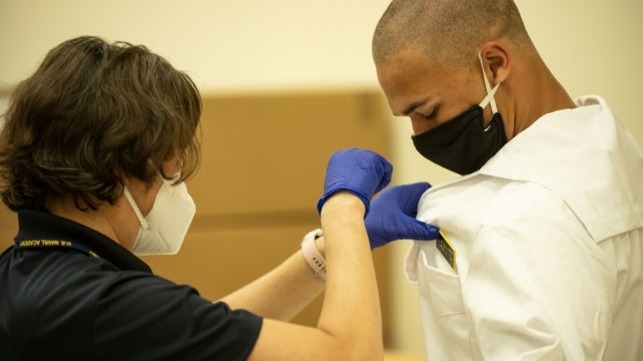COVID-19 Controls Put U.S. Naval Academy On Track to Reopen This Fall

[By Lt. Sarah Ermoshkin]
It has been nearly a month since the first incoming freshmen, or plebes, arrived at the United States Naval Academy (USNA) to check in for their immunizations, vaccinations, blood draws, eyeglasses, and coronavirus (COVID-19) test. Following months of planning and coordination with Naval Health Clinic Annapolis Brigade Medical Unit, plebes have left their restriction of movement status after a second COVID-19 test and are now engaged in summer training.
In previous years, nearly 1,200 plebes would be processed by medical professionals by the afternoon of the first day. In response to the COVID-19 pandemic, the Class of 2024 was processed over four days to maximize social distancing and reduce contacts between possible asymptomatic COVID-19 carriers.
“The mission has not changed. But, the operational approach changed so that we can meet mission requirements,” said Capt. Walter Brafford, commanding officer of Naval Health Clinic Annapolis. “We are doing everything to support the USNA medical mission just as we have in years past. This year, we’ve added one more responsibility, and that’s monitoring plebes’ COVID-19 status.”
Predicting the number of asymptomatic cases that would arrive during induction week was possible due to discussions with other accession points and recruiting commands, and with consultations with a broad range of military public health experts. All midshipmen with active COVID-19 symptoms, persons under investigation for COVID-19, and anyone with symptoms that could not be ruled out by other diagnoses were placed into isolation or quarantine within Bancroft Hall for close monitoring, separated from the other midshipmen.

Image courtesy USN
The plebes are divided into groups of 40, referred to as a “pod.” Within the pod, life exists as usual - as usual as it can be for someone making the transition from civilian to military. Plebes move as a unit, separated by masks and kept at least six feet away from other pods. Every morning, all plebes and detailers undergo a temperature and COVID-19 symptom check.
“We created two types of isolation spaces: a space for those who tested positive and a space for those who tested negative, but have COVID-like symptoms,” said Cmdr. Sara Stires, brigade medical officer. “Our plan is working, and Plebe Summer commenced without issues.”
To date, over 5,000 COVID-19 tests have been performed since the first week of July and another 8,500 tests are planned in the upcoming months in order for the entire population of midshipmen to safely return for the new academic year. In order to continue surveillance, Navy Medicine expects to support the Academy with 600 tests per week, enough to cover about 15 percent of all USNA students and staff.
The opinions expressed herein are the author's and not necessarily those of The Maritime Executive.
